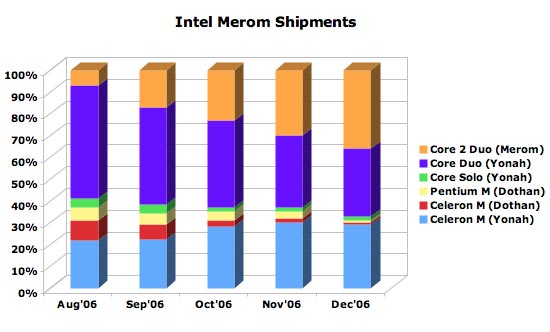Mobile CPU Wars: Core 2 Duo vs. Core Duo
by Anand Lal Shimpi on August 3, 2006 9:25 AM EST- Posted in
- CPUs
Model Numbers Galore
Just like the outgoing Core Duo processor, Intel's Core 2 Duo lineup uses its arbitrarily determined model number system. While the previous Core Duo chips were all numbered as T2000 series processors, the new Core 2 Duos are all T7000 and T5000 chips. The T5000 models feature a 2MB L2 cache while the T7000 have a full 4MB L2, and as the name implies all of these CPUs are dual core.
The table below features all of the Core 2 Duo parts that will be available this quarter:
| CPU | Clock Speed | FSB | L2 Cache | Price |
Intel Core 2 Duo T7600 |
2.33GHz |
667MHz |
4MB |
$637 |
Intel Core 2 Duo T7400 |
2.16GHz |
667MHz |
4MB |
$423 |
Intel Core 2 Duo T7200 |
2.00GHz |
667MHz |
4MB |
$294 |
Intel Core 2 Duo T5600 |
1.83GHz |
667MHz |
2MB |
$241 |
Intel Core Duo T2700 |
2.33GHz |
667MHz |
2MB |
$637 |
Intel Core Duo T2600 |
2.16GHz |
667MHz |
2MB |
$423 |
Intel Core Duo T2500 |
2.00GHz |
667MHz |
2MB |
$294 |
Intel Core Duo T2400 |
1.83GHz |
667MHz |
2MB |
$241 |
Intel Core Duo T2300 |
1.66GHz |
667MHz |
2MB |
$241 |
Intel Core Duo T2300E* |
1.66GHz |
667MHz |
2MB |
$209 |
*Note: These CPUs lack Intel Virtualization Technology (VT) support)
The Core 2 Duo lineup that's being introduced this quarter shows one common theme: price parity. The new Core 2 Duo processors are available at the same clock speeds as the now "old" Core Duo processors and at the same price. For the same price you do get a faster CPU and in most cases twice the L2 cache, but we'll save the performance and battery life comparisons for later on in the review.
The point of Intel's pricing strategy with Core 2 Duo on the mobile side is to quickly phase out out Core Duo and replace it with Core 2 Duo. The chart below details Intel's plans to ramp Core 2 Duo in its mobile segment:

You'll note that Intel is quite aggressive with ramping Core 2 Duo up, but going into 2007 over a quarter of Intel's mobile processor shipments will still be Core Duo.










46 Comments
View All Comments
juanpoh - Friday, August 4, 2006 - link
Looking at http://www.intel.com/products/processor/pentiumm/i...">Intel Pentium M link, only 915 and 855 chipset is supported. However 945 chipset is listed as supported in http://www.intel.com/products/processor/celeron_m/...">Intel Celeron M link.jaybuffet - Friday, August 4, 2006 - link
I have the nx9420 notebook with the 945pm chipset... i was on hp support yesterday, and they said they would not support upgrading the CPU.. does that mean i am SOL because they wont upgrade the BIOS to support it?Pjotr - Friday, August 4, 2006 - link
Please correct the percentage numbers on http://www.anandtech.com/cpuchipsets/showdoc.aspx?...">http://www.anandtech.com/cpuchipsets/showdoc.aspx?..."17.5% increase in performance" -> "17.5 % less time used" OR "21.3 % increaase in performance"
Same mistake for all other time based benchmarks.
shecknoscopy - Thursday, August 3, 2006 - link
Given the nearly identical architectures of the desktop Conroes and the new Merom chips - how well do all of you think the two would stack up in a direct side-by-side comparison? This is open to blatant conjecture, of course, as the necessary hardware to <b>really</b> make a single-variable experiment isn't out there. But for those of us considering mobile-on-desktop options, how much of a performance cut would we see jumping from a Conroe to a Merom?IntelUser2000 - Saturday, August 5, 2006 - link
Intel mentioned something about having different prefetchers that match the market, meaning Woodcrest's Prefetchers are fit for workstation/server, Conroe for desktop, Merom for mobile applications(performance/battery life).
If you look at Core Extreme X6800 vs. Core 2 Duo E6700 benchmarks, you can see that in some reviews the differences are greater than the 267MHz clock difference(10% clock difference). Maybe Core Extreme has superior prefetchers to the Core 2 Duos, giving advantage in select few applications.
Sunrise089 - Thursday, August 3, 2006 - link
This was the exact question I just signed on to ask....so I await and answer as well.shecknoscopy - Thursday, August 3, 2006 - link
Woohoo! Great minds think alike, eh? Also, so do ours!JackPack - Thursday, August 3, 2006 - link
Which stepping did you use in this test? B1?EagleEye - Thursday, August 3, 2006 - link
I think the asus barebones configuration is mislabeled in this article. The s96j has the WXGA 1280x 800 screen while the z96j has the WSXGA 1680x 1050 screen. They either had an s96j or the native resolution is wrong as they stated it.Kalessian - Thursday, August 3, 2006 - link
I noticed that, too.